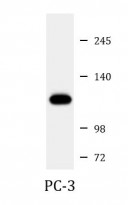ARG55002
anti-USP5 antibody [1340CT704.170.140]
anti-USP5 antibody [1340CT704.170.140] for Western blot and Human,Mouse,Rat
Cell Biology and Cellular Response antibody; Gene Regulation antibody
Overview
| Product Description | Mouse Monoclonal antibody recognizes USP5 |
|---|---|
| Tested Reactivity | Hu, Ms, Rat |
| Tested Application | WB |
| Host | Mouse |
| Clonality | Monoclonal |
| Clone | 1340CT704.170.140 |
| Isotype | IgG1, kappa |
| Target Name | USP5 |
| Antigen Species | Human |
| Immunogen | Recombination protein of Human USP5. |
| Conjugation | Un-conjugated |
| Alternate Names | Ubiquitin-specific-processing protease 5; Ubiquitin carboxyl-terminal hydrolase 5; Isopeptidase T; Deubiquitinating enzyme 5; ISOT; EC 3.4.19.12; Ubiquitin thioesterase 5 |
Application Instructions
| Application Suggestion |
|
||||
|---|---|---|---|---|---|
| Application Note | * The dilutions indicate recommended starting dilutions and the optimal dilutions or concentrations should be determined by the scientist. | ||||
| Positive Control | PC-3 |
Properties
| Form | Liquid |
|---|---|
| Purification | Purification with Protein G. |
| Buffer | PBS and 0.09% (W/V) Sodium azide |
| Preservative | 0.09% (W/V) Sodium azide |
| Storage Instruction | For continuous use, store undiluted antibody at 2-8°C for up to a week. For long-term storage, aliquot and store at -20°C or below. Storage in frost free freezers is not recommended. Avoid repeated freeze/thaw cycles. Suggest spin the vial prior to opening. The antibody solution should be gently mixed before use. |
| Note | For laboratory research only, not for drug, diagnostic or other use. |
Bioinformation
| Database Links |
Swiss-port # P45974 Human Ubiquitin carboxyl-terminal hydrolase 5 Swiss-port # P56399 Mouse Ubiquitin carboxyl-terminal hydrolase 5 |
|---|---|
| Gene Symbol | USP5 |
| Gene Full Name | ubiquitin specific peptidase 5 (isopeptidase T) |
| Background | Ubiquitin (see MIM 191339)-dependent proteolysis is a complex pathway of protein metabolism implicated in such diverse cellular functions as maintenance of chromatin structure, receptor function, and degradation of abnormal proteins. A late step of the process involves disassembly of the polyubiquitin chains on degraded proteins into ubiquitin monomers. USP5 disassembles branched polyubiquitin chains by a sequential exo mechanism, starting at the proximal end of the chain (Wilkinson et al., 1995 [PubMed 7578059]).[supplied by OMIM, Mar 2010] |
| Function | Cleaves linear and branched multiubiquitin polymers with a marked preference for branched polymers. Involved in unanchored 'Lys-48'-linked polyubiquitin disassembly. Binds linear and 'Lys-63'-linked polyubiquitin with a lower affinity. Knock-down of USP5 causes the accumulation of p53/TP53 and an increase in p53/TP53 transcriptional activity because the unanchored polyubiquitin that accumulates is able to compete with ubiquitinated p53/TP53 but not with MDM2 for proteasomal recognition. [UniProt] |
| Research Area | Cell Biology and Cellular Response antibody; Gene Regulation antibody |
| Calculated MW | 96 kDa |
Images (1) Click the Picture to Zoom In






